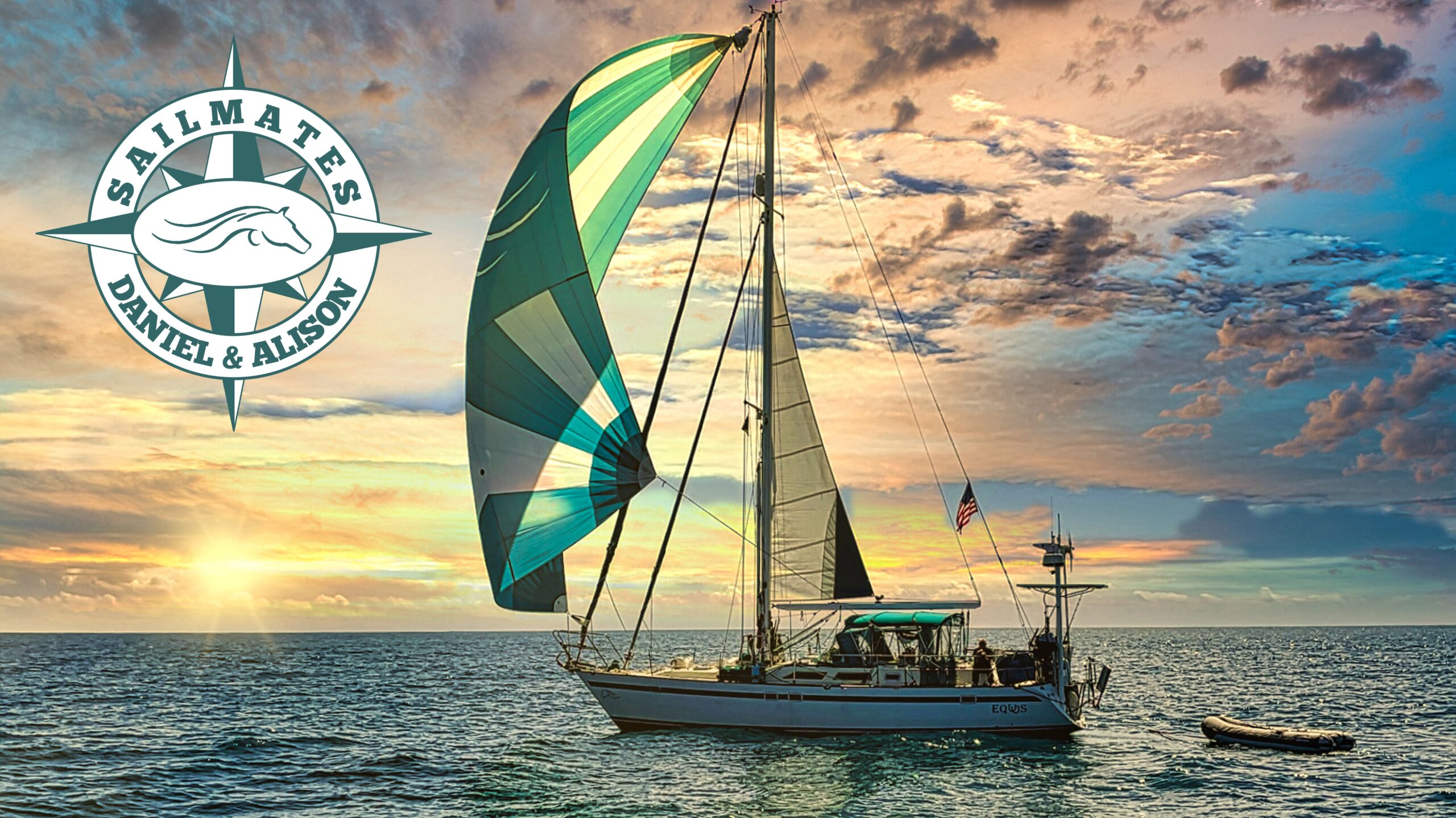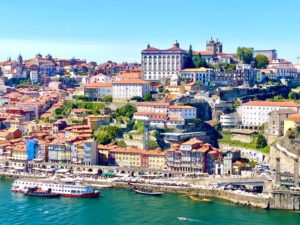“I am learning to trust the journey even when I do not understand it.” – Mila Bronit
It was so exciting to sight land in Spain upon safely crossing the Bay of Biscay. It was our first European mainland landfall on our voyage thus far. I was finally getting to visit a part of the world I had never seen. It amazed me we had traveled this far on our little boat. We pulled into a little harbor just outside of the city, A Coruna. Exhausted from our 4-day passage, we caught up on rest and sleep.
There are some things you discover for yourself that you wish you had learned about prior to that discovery. Many people I know have spent time in Spain, yet it turns out I knew very little about the culture. Here are some of the lessons I learned through experience – some might argue the best teacher.
Spain 101
1. Spain closes during Siesta.
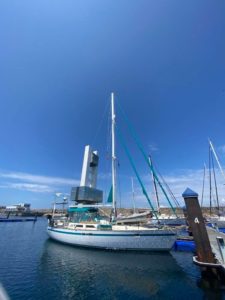
In addition to being legal visitors, we also have to worry about Schengen rules. Once we check into a European country belonging to Schengen, we only have 90 days to visit and then we must leave. We must remain outside the Schengen countries for 90 days before we are allowed to return. The following morning after our arrival, we checked into the A Coruna Marina to refuel and complete our check-in.
We found our slip and made our way to the marina. The office staff didn’t speak English. When we showed our paper and passports, a lady nodded and gave us an information sheet in English. The sheet stated that we could check in electronically. This is all good in theory, however, if your passport is not stamped you have no proof of entry. This could cause serious problems down the line. Dan pulled out his phone and looked up the nearest government office to get our passports stamped.
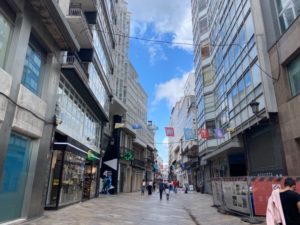
Deciding to do some exploring, we searched maps for a store where I could get a few supplements I needed. Health food stores don’t exist in Spain – to our knowledge anyway. A sort of health pharmacy was a few miles away, so we set off to find it.
It was hot. We were not used to the heat having been frozen for the summer in the northern latitudes. Hot and tired, we finally found the store deep in the city. It was closed. For siesta. Fortunately, it opened in a few minutes so we waited. Having a thought, Dan looked again at the police station hours. Turned out they also reopened in the evening. We were so far away at this point; we wouldn’t make it there. Had we known about siesta hours, we could have gotten our passports stamped and been on our way. Our bad!
2. Dinner is not served until 8:00 pm in Spain.
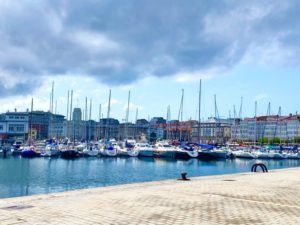
Can you imagine our dismay? We had walked about 6 miles in total, were tired, starving, and not one restaurant seemed to have any food. We couldn’t find anyone who spoke English. Every restaurant we passed had a few people seated outside drinking beverages, but no one was eating meals. It was very confusing.
By 7:30, I was near starvation. We only had a small lunch at noon. Between the refueling and docking process, checking in, and trek through an unknown city, I was ready to chew my arm off. We headed back to the boat, disappointed, and I threw together a meal.
3. Brush up on the language of the country you are visiting – especially menu items.
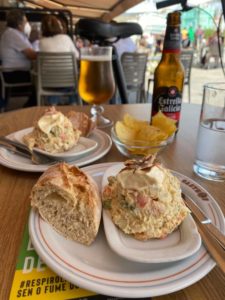
The next day, we tried a new strategy. We were going to try tapas for lunch as several of our friends who had been to Spain raved about the tapas. We had a hard time in this crowded city finding an empty outdoor table, but we finally prevailed. It took forever for a waiter to appear. Dan ordered his cervesa (beer), I ordered agua (water), and we were handed a menu. We recognized the words tapas, but nothing else.
We hailed the waiter and had a totally useless attempt to understand what the items were, so I pointed to something that looked akin to the word quesadilla and ordered “dos”. I wanted to know what I ordered so I pulled out Dan’s phone and opened the translator app.
After several minutes of the waiter fruitlessly yelling into the phone in Spanish and just getting the word quesadilla – he shook his head and disappeared. He came back with 2 servings of what we ordered. Thank God it wasn’t squid. That seemed to be the most popular item everyone around us was ordering. I don’t do tentacles or eyeballs. Thankfully, it also wasn’t sardines. I wasn’t ready for those either.
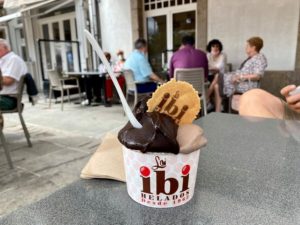
The following day we rode our bikes around the city. A Coruna was very bike-friendly and had great bike lanes to navigate safely. We tried to visit the city’s aquarium, but because of Covid, you had to have advanced tickets. Several landmarks were within biking distance so we enjoyed being out and about, taking in the scenery. We ate lunch on the boat before we left, and once again, by 7:30 after biking 12 miles, we were starving so again, we didn’t get to eat dinner in Spain.
Orca Issues
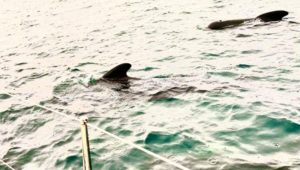
Monday came and we walked to the police station and got our passports stamped. Once again, we had language barrier issues trying to find the passport office. We waited in long lines but eventually found the office and got the job done. Wheh.
Leaving the marina that afternoon, we returned to the small harbor we anchored in on arrival, just a couple of miles from the city. Dan was on his phone looking up the weather when he learned that a sailboat was attacked by Orcas the day after we arrived. It was only a few miles from the harbor, exactly where we had sailed. We counted our blessings we arrived safely.
Dan planned our route south making sure that we sailed to harbors by hugging the coast. No orca issues have been recorded close to shore. Meanwhile, the area surrounding Gibraltar, which was on our route, has been closed to boats under 14 meters in length. We are 13 meters. 26 boats have suffered damage and had to be towed in recently, and that part of the ocean has been restricted. What can we do? Plan day-to-day and take one day and one harbor at a time.
Coastal Spain
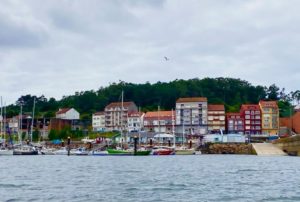
It’s probably true there are not a lot of tourists in these small towns. The bigger, more popular destinations and larger cities most likely are more suited for English speakers. Unfortunately, our range of where we can visit is more limited. Speaking of limited, that brings me to lesson number 4.
4. Clothing is optional on beaches in Spain.
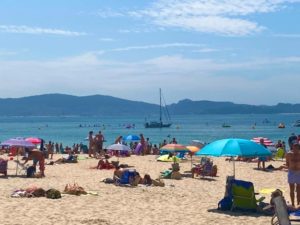
We had intended to go into the marina but they had no room for us so we anchored right off the busy beach. It was kind of cool, having the best view of the vacation hotspot. We had some packages delivered to the marina and took a walk around the town.
The town featured a huge open-air market. We bought three kinds of cheeses, some meat, and an apple had a picnic in a park. It was a lovely day.
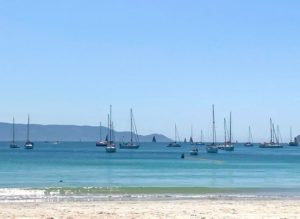
We spent three days at De Barra. We had a lovely day hike and visited the lighthouses. By day 3 we got used to naked people swimming by our boat, naked people paddleboarding, kayaking, playing paddleboard on the beach. It truly was a naturalist’s dream. However, that brings me to the last lesson I learned in Spain.
5. It’s cold in Spain, even in the summer.
As soon as the sun went down, the temperature plummeted. I guess the breeze coming off the cold Atlantic water keeps the coast quite cool, even in the summer. I had been so excited about heading south, I put all my cold weather clothing away in storage bags after we crossed Biscay. I had to pull them back out.
At night, we slept with a sheet, comforter, and thick fleece blanket. We had to turn our diesel heater on to warm the boat up in the mornings. After the sun came out for a while, it usually warmed up nicely. The water temperature was not warm enough yet to lure me to take a swim. I dipped a toe or two in but could not bring myself to take a plunge. Lots of people did swim. The people who live in Spain spend hours in the water and are fine with the temperature.
Porto Portugal
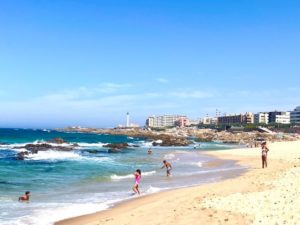
What drew my attention immediately about the coast of Portugal is the amazing beaches. Unlike Spain, where there are beautiful beaches tucked along the coast, the entire coast we sailed along Portugal is one, gigantic, sandy white beach. Currently, we are anchored a few miles from the city. The port where we are located is also a busy shipping port. This has its advantages and disadvantages.
I’m constantly amazed by the gigantic ships coming in and out of the port. Dan was a merchant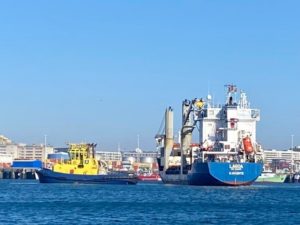
It is very windy here most of the time which makes the beach-going a bit different than in the states. No one comes to the beach without windscreens, umbrellas, or tents. There are even tent-like dwellings on many beaches that people rent – like little houses. People nestle against rocks, blockade themselves inside several screens, and prop umbrellas on their sides as windbreaks. This creates a very unique visual appearance to their beach.
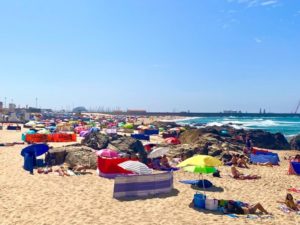
Historic Porto

The churches, castles, and amazing architecture are reflections of the various cultures that built the city into what it is today. Of course, its main fame is being the home of port wine. Port was created when the British added Brandy to wine casks to prevent wine from spoiling during shipping. The fermentation was halted, the sugar levels increased, and the sweet and high alcohol wine became a tradition.
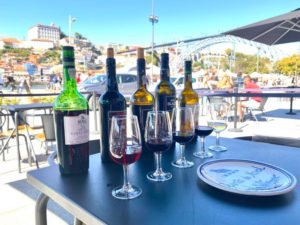
Our main goal was to visit the historic port houses. These houses date back to the British era where port and other wines were created and stored. The grapes were shipped in from various regions of Portugal. Today, you can take a tour and learn about the history. Each house also offers a tasting of the beverages they produce. We took one tour and did a tasting. Both were divine.
More Ports in Portugal
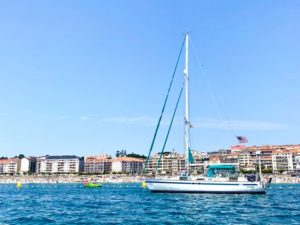
Between Orcas and Covid, everything is pretty much a crapshoot. We don’t know what our long-term goal is since we can’t get around Gibraltar at the moment. We may skip the Med for now and head to the Canary Islands. From there, we would like to sail back across the Atlantic to the Virgin Islands for the winter. However, if we have learned anything about this journey since we have resumed from our Covid delay, life has changed so much that we can’t rely on anything we previously planned.
While this journey is not always easy, certainly not what we expected, and I may not understand everything, I am trusting the outcome. We will move in whatever direction the wind takes us. We do our best to enjoy each new destination, wherever that may be, and we learn so much along the way. I love sharing our adventures with friends and family and hope that in your personal journey, you too are finding happiness, good health, and great adventure.
BTW: If you like my photos and would like to support our journey, please visit my new online photography store: Sailmates Reflections on Redbubble. Even if you don’t purchase you can help get the word by liking and sharing!
And if you haven’t seen our YouTube Channel – Sailing Equus – check out our latest video blogs. Please like and subscribe.
Fair Winds,
Alison and Dan
s/v Equus

